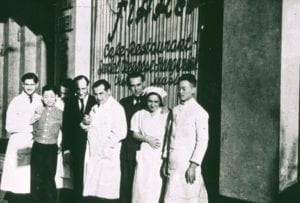[date unclear] 1946
To the Chief of Police
DI LAY YIO
Dear Sir,
I herewith take the liberty to bring a matter of nuisance to your knowledge.
Foreign women living at 992. Tongshan Road have to pass on their daily errands to and from the market a stretch of the Tonsghan Road between Paoting and Dalny Road and every day subject of holiganismus by a small gang of chinese youth who are hurling stones at the passing women. Since my 72 years old mother is among the sufferers I ask you respectfully to stop such fortcomings.
I am very gratefull for your kind consideration
your obedient
Hans Jabloner
[source: SMA Q149 上海市警察局北提篮桥分局]
The story of Shanghai’s Central European Jewish refugees, fleeing primarily but not exclusively from post-Kristallnacht Nazi Germany including post-Anschluss Austria (both in 1938), is increasingly well-known thanks to the memoirs of survivors and some great scholarly works written in recent years. Virtually the only safe haven on earth at this time when people persecuted for their supposed “racial origins” and/or political views could relatively easily settle if temporarily, was the great East Asian metropolis on the Huangpu/Whampoo River (黄浦江). Single individuals and entire families left their homes with little or more commonly none of their possessions to save their sheer lives and move in shabby apartments on an alley of Japanese-occupied Hongkou/Hongkew District (虹口区) that was to be also known as the “Shanghai Ghetto”. Most of them were either educated intellectuals: doctors, lawyers etc. or businessmen who sought to re-establish themselves in the “Far East” to be able to provide for their families.
As many of the memoir-literatures remember, one of the café-restaurants in town that was run by people who brought the tastes of Danubia with themselves, was the famous Fiaker. The “Cosy Viennese Cafe-Restaurant” was opened in 1938 on one of the French Concession’s major roads: Avenue Joffre (today: Huaihai Road 淮海路). It offered “Special Viennese & Hungarian Cuisine” – most importantly “under foreign Chef”, while on the piano “Pepi” entertained the customers. (To whomever the name “Pepi” referred to.) It is unclear, how many of the poor refugees were actually able to afford, say a Sachertorte in the rather high-end establishment, that Chinese and foreign celebrities frequented, including political figure Mme Sun Yat-sen neé Song Qingling (宋庆龄), opera-singer Mei Langfang (梅兰芳) or writer and novelist Pearl S. Buck.

As we’ve seen by the time of our source quoted above, public order and safety in postwar Shanghai was just as pressing issue as the rising anti-foreign sentiments, of which we could speculate from the behavior of some “hooligan youth”. One of the two proprietors of the Fiaker, Hans Jabloner (his partner being Fritz Strehlen) wrote this complaint to the Tilanqiao Police Station (提兰桥分局) in Hongkou, that was supposed to be in charge of the streets where his elderly mother apparently fell victim of the reckless aggression. Unfortunately, this is the only file I was able to find related to the reported incident, which by itself certainly can’t be held up as a representative image depicting the nature of relations between local Chinese and refugee Jews in general. Nevertheless, it might complicate the generally preferred and promoted narrative of peaceful and tolerant acceptance of the persecuted ones, one that greets the visitor of public museums, including the Shanghai Historic Museum (上海历史博物馆), or the Shanghai Jewish Refugees Museum (上海犹太难民纪念馆).
Notes on source: I intentionally left the typos and errors as in the original when transcribing the letter. Some of the spelling-mistakes and linguistic habits can identify the writer as a native German-speaker. (Being a native Hungarian-speaker, some issues of similar kind can most probably be found in my own writings, I fear…) As for the “DI LAY YIO” in the address section, I believe that is a corrupted version of “Tilanqiao” that probably derives via the Shanghainese pronunciation, the area within Hongkou, mentioned the third paragraph of my post.